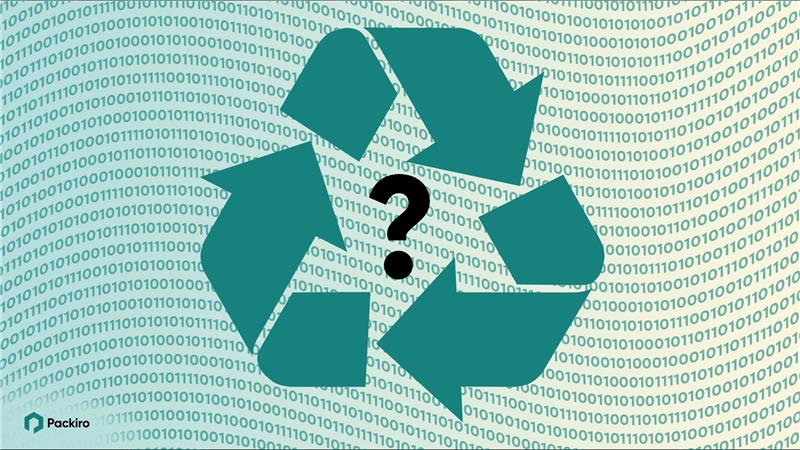
What is the meaning of the recycling sign?

While examining packaging close up, you will often notice various combinations of symbols, icons and identification codes. From packaging to bins, understanding recycling symbols is key to improving sustainability, complying with regulations, and building consumer trust. But with so many packaging and recycling symbols, it can be confusing, and not just for your customers. What do the small codes on packaging really mean? In this article, we will debunk all the myths surrounding the recycling symbol. We have also created a practical checklist that you can download for free!
Created on 28.07.2025Content
What are recycling signs?
Whether on retail shelves or on online orders, many packages have certain symbols, icons and codes printed on them, often in various combinations. But why are they there and what do they mean?
Recycling signs are pictograms on packaging that provide information about the material the packaging is made of and whether it can be recycled. These are usually a combination of symbols, numbers and letter abbreviations. What virtually all common recycling codes have in common is the familiar recycling symbol with the three arrows.
What Is the Recycling Symbol?
The most well-known recycling sign is the so-called ‘Möbius loop’. Most people think of this icon when talking about the Recycling symbol.
You can think of the Möbius loop as the universal recycling symbol: a triangle formed by three chasing arrows that fold in a loop.

Where Did the Recycling Symbol Come From?
The classic recycling sign was originally created in 1970 by American graphic designer Gary Anderson. Its Möbius loop design—three arrows chasing one another—symbolises an infinite, closed-loop recycling process.
In 1988, the Society of the Plastics Industry (SPI) introduced a standardised set of resin identification codes, combining the symbol with numbers and abbreviations. Today, this system forms the basis for many recycling symbols on packaging globally and the Möbius loop remains the globally recognised indicator for recycling potential.
Recycling Symbol vs Recycling Code: What’s the Difference?
When talking about the recycling sign, we usually refer to the general three-arrow icon known as the Möbius loop.
A recycling code, on the other hand, includes extra details—like a number (e.g. 5) or material code (e.g. PET)—which indicate the specific type of plastic or packaging material.
So, while a picture of the recycling sign gives a general message, the recycling symbol chart helps determine how and where an item can be recycled.
Why Do We Need Recycling Symbols?
Recycling symbols are intended to provide consumers and retailers with information about the recyclability of packaging materials.
They serve as a somewhat guide for the environmentally friendly disposal of packaging materials within the recycling system.
They are also an important indicator of how packaging materials should be sorted appropriately for disposal.
In short: They're not just for show: they help reduce contamination in recycling streams such as plastic recycling and ensure proper waste management with regard to the Three Rs from the waste management hierarchy.
What do the recycling symbols on packaging mean?
Nowadays, you can find a wide variety of recycling codes on packaging. The Consumer Advice Centre has counted a total of 31 recycling codes.
The meaning of the various recycling codes always refers to the composition of the respective packaging. In addition to the typical recycling symbol with the three black arrows, you will always find a specific number in the middle of the symbol and, if applicable, an identifier for the packaging material.
The classic recycling symbol with the three arrows in a triangle is the same for all recycling codes, while the number and letter identification varies depending on the packaging material or product used.
The numbering and letter abbreviations are based on the coding system introduced by the Society of the Plastics Industry (SPI) – the ‘SPI resin identification coding system’.
Today, they still refer to the respective type of packaging. Recycling symbols containing the numbers 01 to 07, for example, can always be found on packaging made from plastic materials.
Depending on the type of packaging, there are specific symbols for
Plastics
Paper and cardboard
Textiles
Wood materials
Metals
Glass
Composites
The codes are therefore made up of the abbreviation of the material designation and an identification number that specifies the type of material. For example, the abbreviation ‘PAP’ indicates that the packaging is made of paper, while ‘05: PP’ specifically stands for the thermoplastic material type polypropylene.
Here are two examples: ‘71: GL’ stands for packaging made of pure glass, while the number 71 specifies that it is green glass.
In contrast to composite materials, which are made up of different materials, abbreviations such as ‘PAP’, ‘GL’, “TEX” and ‘PP’ stand for mono-materials, i.e. packaging made from only one type of material.
The recycling code for composite packaging can be identified by the number (from 80 to 98) and the typical abbreviation ‘C/’, followed by the abbreviation for the main component of the material. An example of a recycling code for a composite material made of plastic and aluminium could be: ‘90: C/LDPE’.
All this information helps consumers and businesses to separate packaging materials correctly when disposing of them.
We captured all of these information in a practical overview. Download it for free now:
UK Recycling Signs and What They Mean
In the UK, the recycling sign on packaging typically indicates:
The material a package is made from
Whether it can be widely recycled
How to dispose of it correctly (e.g. via mixed recycling, general waste, or kerbside collection)
Widely Recycled

The Widely Recycled logo is a recycling sign that is specific to the UK and some other countries. It specifically marks packaging that is accepted for recycling by at least 75% of local UK authorities.
It helps consumers identify items that are most likely to be collected and recycled through regular curbside programs.
Apart from the Widely Recycled symbol, there are two more similar symbols you may recognise:
♻️ Widely Recycled – Rinse Before Recycling: This symbol means the packaging is accepted by the majority of local councils across the UK. However, it includes a reminder to rinse the item—such as a food tray or container—before recycling.
Rinsing removes food residue that could otherwise contaminate other materials, particularly paper or cardboard collected in the same stream. It also helps maintain hygiene and prevent vermin in recycling centres, where people sort materials by hand.🚫 Not Currently Recycled: This label indicates that less than 20% of local authorities are able to process this type of packaging. In most areas, items with this symbol cannot go into the recycling bin and should be placed in general waste.
These British recycling symbols are found on everything from food packaging to cosmetics, offering quick, clear guidance.
According to research data provided by WRAP (Waste & Resources Action Programme), 76% of people in the UK say they regularly check packaging labels for recycling instructions — a number that keeps rising.
Why Recycling Symbols Matter for Businesses
If you sell or ship products in the UK, you must comply with The Packaging Waste Regulations. But beyond compliance, there’s a strategic benefit.
3 Reasons Business Owners Should Care About Recycling Symbols
Customer Trust: According to the 2023 Global Buying Green Report by Trivium Packaging, 71% of consumers consider sustainability when choosing products. Over 82% said they would pay more for eco-friendly packaging.
Brand Differentiation: Using packaging with clear, recognisable recycled signs and “Widely Recycled” labels can help position your brand as environmentally responsible.
Circular Economy Compliance: Properly labelled packaging supports creation of a circular economy, reducing landfill and boosting material recovery.
In addition to identifying the material, they also contribute to a sustainable circular economy by promoting recycling. Recycling symbols on packaging also help consumers make purchasing decisions. After all, more and more people prefer sustainable packaging materials and are more likely to choose packaging that is recyclable. This was recently demonstrated in the ‘Global Buying Green Report’ 2023 by Trivium Packaging. It shows that for 71% of consumers, the sustainability factor of product packaging plays a decisive role in their purchasing decisions. 82% of respondents even stated that they would be willing to pay more for sustainable packaging.
Our Packiro packaging Martha and Toni are made from mono-materials, which is why they actively support the circular economy and recycling processes! ⬇️
Conclusion: Recycling symbols and why they matter
Recycling symbols and signs play a crucial role in today's packaging world. They have an important informative function by promoting waste separation and recycling of packaging, thereby contributing to a functioning and sustainable circular economy. This in turn means that valuable resources can be reused and others saved.
But it's not just the environment and consumers who benefit from recycling symbols on packaging — they can benefit you and your business, too. If your product packaging is clearly recyclable at a glance, it will convince many sustainability-conscious customers of your brand's commitment to sustainability.